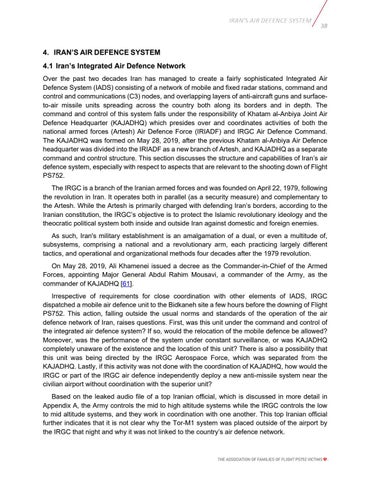38
4. IRAN’S AIR DEFENCE SYSTEM 4.1 Iran’s Integrated Air Defence Network Over the past two decades Iran has managed to create a fairly sophisticated Integrated Air Defence System (IADS) consisting of a network of mobile and fixed radar stations, command and control and communications (C3) nodes, and overlapping layers of anti-aircraft guns and surfaceto-air missile units spreading across the country both along its borders and in depth. The command and control of this system falls under the responsibility of Khatam al-Anbiya Joint Air Defence Headquarter (KAJADHQ) which presides over and coordinates activities of both the national armed forces (Artesh) Air Defence Force (IRIADF) and IRGC Air Defence Command. The KAJADHQ was formed on May 28, 2019, after the previous Khatam al-Anbiya Air Defence headquarter was divided into the IRIADF as a new branch of Artesh, and KAJADHQ as a separate command and control structure. This section discusses the structure and capabilities of Iran’s air defence system, especially with respect to aspects that are relevant to the shooting down of Flight PS752. The IRGC is a branch of the Iranian armed forces and was founded on April 22, 1979, following the revolution in Iran. It operates both in parallel (as a security measure) and complementary to the Artesh. While the Artesh is primarily charged with defending Iran’s borders, according to the Iranian constitution, the IRGC’s objective is to protect the Islamic revolutionary ideology and the theocratic political system both inside and outside Iran against domestic and foreign enemies. As such, Iran's military establishment is an amalgamation of a dual, or even a multitude of, subsystems, comprising a national and a revolutionary arm, each practicing largely different tactics, and operational and organizational methods four decades after the 1979 revolution. On May 28, 2019, Ali Khamenei issued a decree as the Commander-in-Chief of the Armed Forces, appointing Major General Abdul Rahim Mousavi, a commander of the Army, as the commander of KAJADHQ [61]. Irrespective of requirements for close coordination with other elements of IADS, IRGC dispatched a mobile air defence unit to the Bidkaneh site a few hours before the downing of Flight PS752. This action, falling outside the usual norms and standards of the operation of the air defence network of Iran, raises questions. First, was this unit under the command and control of the integrated air defence system? If so, would the relocation of the mobile defence be allowed? Moreover, was the performance of the system under constant surveillance, or was KAJADHQ completely unaware of the existence and the location of this unit? There is also a possibility that this unit was being directed by the IRGC Aerospace Force, which was separated from the KAJADHQ. Lastly, if this activity was not done with the coordination of KAJADHQ, how would the IRGC or part of the IRGC air defence independently deploy a new anti-missile system near the civilian airport without coordination with the superior unit? Based on the leaked audio file of a top Iranian official, which is discussed in more detail in Appendix A, the Army controls the mid to high altitude systems while the IRGC controls the low to mid altitude systems, and they work in coordination with one another. This top Iranian official further indicates that it is not clear why the Tor-M1 system was placed outside of the airport by the IRGC that night and why it was not linked to the country’s air defence network.








